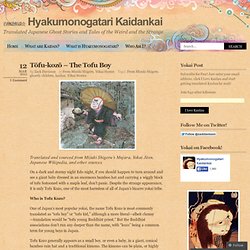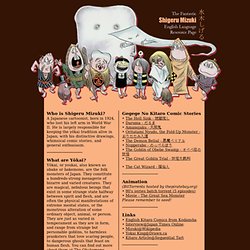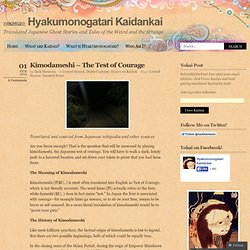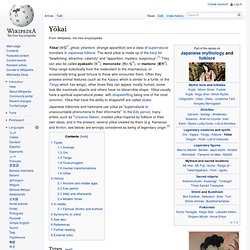

Tōfu-kozō – The Tofu Boy « 百物語怪談会 Hyakumonogatari Kaidankai. Translated and sourced from Mizuki Shigeru’s Mujara, Yokai Jiten, Japanese Wikipedia, and other sources On a dark and stormy night Edo night, if you should happen to turn around and see a giant baby dressed in an enormous bamboo hat and carrying a wiggly block of tofu festooned with a maple leaf, don’t panic.

Despite the strange appearance, it is only Tofu Kozo, one of the most harmless of all of Japan’s bizarre yokai tribe. Who is Tofu Kozo? One of Japan’s most popular yokai, the name Tofu Kozo is most commonly translated as “tofu boy” or “tofu kid,” although a more literal—albeit clumsy—translation would be “tofu young Buddhist priest.” But the Buddhist associations don’t run any deeper than the name, with “kozo” being a common term for young boys in Japan. Tofu Kozo generally appears as a small boy, or even a baby, in a giant, conical bamboo rain hat and a traditional kimono.
There is little agreement about Tofu Kozo amongst writers. The Origin of Tofu Kozo. The RPG Haven - View topic - New Project - Codename: Kaidan* New Project - Codename: Kaidan* I totally stole that title format from clash.

Although I am also gathering resources and making notes elsewhere, I thought I'd show a little bit here too. This is the game I mentioned in the other thread. When/Where: Sengoku period Japan.Set-up: PCs are ghosts of bushi recruited to serve the Queen of the Northern Yokai Court. Here's the idea I'm fiddling with right now: spirit beings (all manner of yokai and ghosts) are essentially dedicated to specific purpose.
In addition to having less mojo to use when not acting in accordance with their purpose, beings often get easily distracted and forgetful. Mechanically speaking, I see some kind of resource associated with a being's purpose. Kappa protecting his stream can use his Purpose at a 1:1 ratio. More powerful beings have the advantage of having a broad Purpose, but they also are less prone to being easily distracted and forgetful. *I am using Kaidan because it carries the sense of Weird Tales. The Fantastic Shigeru Mizuki English Language Resource Page. A Japanese cartoonist, born in 1924, who lost his left arm in World War II.

Kimodameshi – The Test of Courage « 百物語怪談会 Hyakumonogatari Kaidankai. Translated and sourced from Japanese wikipedia and other sources Are you brave enough?

That is the question that will be answered by playing kimodameshi, the Japanese test of courage. You will have to walk a dark, lonely path to a haunted location and set down your token to prove that you had been there. The Meaning of Kimodameshi Kimodameshi (肝試し) is most often translated into English as Test of Courage, which is not literally accurate. The History of Kimodameshi Like most folkloric practices, the factual origin of kimodameshi is lost to legend. In the closing years of the Heian Period, during the reign of Emperor Shirakawa (1073 to 1087), the book “O-kagami” (大鏡; “Great Mirror”) was written by an unknown author. Online Gallery. Fine Prints: Japanese, pre-1915 - About this Collection - Prints & Photographs Online Catalog. All images are digitized | All jpegs/tiffs display outside Library of Congress | View All The Prints and Photographs Division houses more than 2,500 Japanese woodblock prints and drawings, dating from the seventeenth to the twentieth centuries, by such artists as Hiroshige, Kuniyoshi, Sadahide, and Yoshiiku.

One-hundred ghosts stories. By Taiso Yoshitoshi Ghosts stories were popular in Japan.

One-hundred persons liked to gather by the light of one-hundred candles and tell scary tales. Each time a legend was finished, one candle was blown out and the next person began. When Yoshitoshi created 100 ghosts stories of Japan and China, he used this tradition. Twenty-six selected designs and a title page were published in 1865. The woodblocks are difficult to understand for Westerners. The prints are listed in the order used by Stevenson. Jan van Reek Mary Deeming gave me the images of One-hundred ghosts stories for an exhibition on the internet. The Obakemono Project ~ Introduction.
Yōkai. Ukiyo-e print of yōkai, by Aotoshi Matsui Japanese folklorists and historians use yōkai as "supernatural or unaccountable phenomena to their informants".

In the Edo period, many artists, such as Toriyama Sekien, created yōkai inspired by folklore or their own ideas, and in the present, several yōkai created by them (e.g. Kameosa and Amikiri, see below) are wrongly considered as being of legendary origin.[2] Types[edit] There are a wide variety of yōkai in Japanese folklore. Animals[edit] Many indigenous Japanese animals are thought to have magical qualities. Oni[edit] Tengu[edit] A goblin from Japanese mythology that has several supernatural powers and skills in martial arts, the tengu were originally extremely dangerous demons and enemies of Buddhism.
Tsukumogami[edit] Tsukumogami are an entire class of yōkai and obake, comprising ordinary household items that have come to life on the one-hundredth anniversary of their birthday. Human transformations[edit] Lovely Bloodflow. List of legendary creatures from Japan.